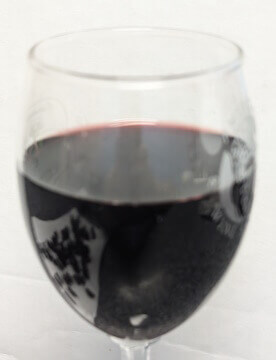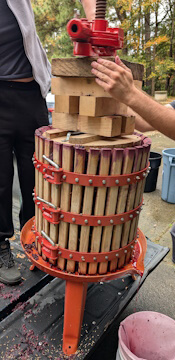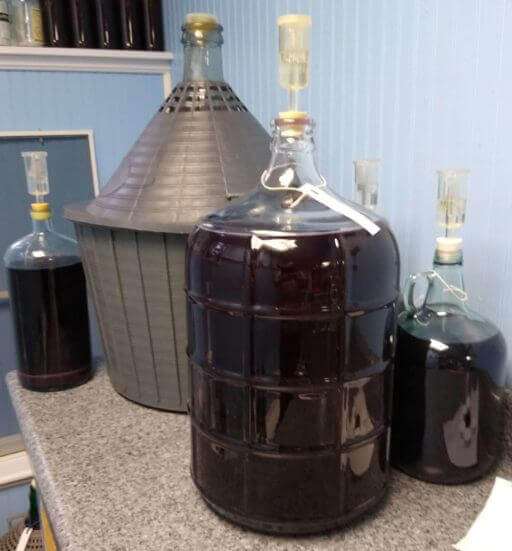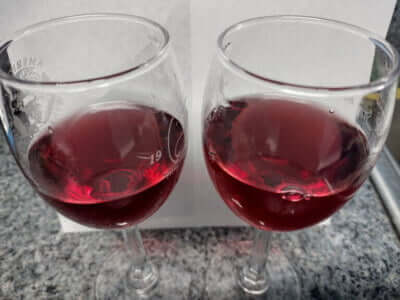Making A Second Run Wine
updated 02/22/2025
After pressing a wine, about 20% of the original grape weight is “pomace”, the solids which will include skin, seeds, pulp, and stems. This is typically discarded, and may be composted.
The pomace still has a lot of “goodness” in it. Making another wine using the pomace makes use of that “goodness”, producing more wine at a very low cost. This wine is lighter in body, ages faster, and is drinkable while the first run wine ages. Second run wines typically have a much shorter self life, but that is rarely a problem.
Problem with Second Run Wines

Second run wines have a bad reputation in some quarters, one that is not fully deserved.
Why the bad reputation? It’s actually not the wine, it’s one step in the process that makes the difference between a very nice (if lighter bodied wine) and one that is little more than colored alcohol.
That step is the pressing of the first run wine. It’s a trade-off. The harder the first run is pressed, the less “oomph” is left for the second run, resulting in a wine that lacks character. But if the first run isn’t pressed hard, the wine is being left behind in the pomace so there is less first run wine.
It’s not possible to have both. This post considers various approaches.
Note: The traditional process for second run wines is to add water, sugar, acid, and tannin, and let a renewed fermentation extract enough constituents from the pomace to make an acceptable wine.
No Pressing
One of my early mentors had an interesting approach. He purchased 1,500 lbs of grapes each fall, alternating between reds and whites. He’d ferment the wine dry, drain the first run wine from it with no pressing.
For each 2 gallons of first run wine, he would add:
- 1 gallon water
- 2 lbs sugar
- 1/2 to 1 tsp acid blend
- 1/4 tsp grape tannin
I cannot recall if he added yeast nutrient, which is a good idea.
He’d ferment the second run dry, then drain off the free run wine, which would be about half the volume of the first run. Then he’d press the pomace, and he called the results the “squeezins”. This wine was divided so that 2/3 went into the first run and 1/3 went into the second run. This filled 3 barrels.
He had separate red and white barrels. The reds were bottled after 2 years of barrel aging, when the next red was ready for barrel. The whites were bottled after 1 year, and the barrels filled with a holding solution until the next white was ready for barrel.
This worked well, and his second run wines were as good as many first run wines.
Second Run 2019

In 2019 I made grape wine for the first time in twenty years. The previous time, in 1999, the grapes were low quality and I ended up dumping the wine, as it was really bad. That turned me off NC grapes.
In July 2019, I connected with a Durham NC based group that had CA grapes trucked in. I purchased Malbec, Merlot, and Zinfandel, and decided to make a second run wine from the combined pomace of all three.
Using a basket press, I did a “light” pressing, enough to get 15 gallons of wine as the second run was going into a used (neutral) 54 liter barrel I had just purchased. I didn’t have enough of any of the first run wines, and needed to fill the barrel. After 30 years of winemaking I had my first barrel and fully intended to use it!
Note: The degree of pressing in a basket press is “by eye”. There is no gauge, so the level of the pressing is judged by the winemaker’s experience. I hadn’t pressed wine in twenty years, so I admit my judgment was less than stellar.
Also, I pressed the first run wines at SG 1.008 to 1.012, which is high. In hindsight, I should have let them go to 1.000 or less. However … leaving that much “goodness” in the pomace was a factor in how good the second run came out.
I didn’t follow the recipe exactly, and fermented each of the grapes separately. My notes on this batch are here. In hindsight I added too much sugar, as I thought the SG was too low. More on this later.
Note: I did not add tannin; it’s possible I didn’t have any and didn’t think ahead. [I cannot recall, which is why I record notes!]
When the SG was 1.002, I pressed 5 gallons from each batch, which collectively went into a 54 liter demijohn to clear. [Those experienced with barrels will notice the mistake I made here.]
Then I hard pressed the remaining pomace, and this wine was segregated, and later called “Squeezins”, as my mentor called the final pressing. This wine was noticeably darker and richer than the regular second run pressing.
Both wines (regular and Squeezins) stopped at 1.000 and refused to ferment further, even with a fresh inoculation with EC-1118. So I filled the barrel.
A few months later both wines restarted fermentation, and the barrel bung was blown 3 mornings in a row. I learned to NOT put wine in a barrel unless I was 101% positive it was done fermenting!
Oh, the mistake I mentioned above? I lost a liter of wine to sediment when the wine settled in the demijohn, and after filling the barrel I had 2 liters of topup wine. The barrel loses about 10% of the volume per year, so I quickly ran out of topup. Fortunately, I had the Squeezins, and used that for topup, which improved the quality of the wine.
When the next fall’s wine was ready for barrel, we bottled both batches. More on these later.
Second Run 2020
 The following fall I was prepared for the barrel, having learned a lot of important lessons. I also purchased a second neutral barrel from the same couple that I purchased the first one from, so I was ramped to fill both.
The following fall I was prepared for the barrel, having learned a lot of important lessons. I also purchased a second neutral barrel from the same couple that I purchased the first one from, so I was ramped to fill both.
The 2019 second run taught some good lessons, one of which was SG management. I realized after the fact that the wonky SG readings I got were perfectly normal.
Take sugar water at 1.090. Blend into it the pomace – which has some quantity of wine remaining with an SG between 0.995 and 1.010 – and the SG after blending will always be less than 1.090. The final SG will depend on the amount of sugar water, the amount of wine remaining in the pomace, and the SG of that wine. A reading of 1.050 may be perfectly normal.
Mix the sugar water and pomace, record the SG, and don’t add more sugar. After the wine is fermented, the ABV (Alcohol By Volume) can be calculated using the OG of both the wine and the sugar water, the FG of the second run wine, and the relative volumes of the sugar water and the wine left in the pomace.
Hint: If 5 gallons of sugar water is added and the pressed volume is 6 gallons, the amount of wine left in the pomace is 1 gallon.
This wine was noticeably lighter than the 2019. It was ok, but not great. I was disappointed after the high quality of the 2019 second run.
Lessons Learned
In hindsight, I realize why the 2020 second run was no where near as good as the 2019:
SG of the first run at pressing:
For the 2019 the SGs were 1.008 to 1.012. For the 2020, the SGs were 0.996 to 0.998. The 2019 pomace had a lot more “oomph” left in it, so there was more to extract.
Note that I was somewhat disappointed with the 2019 first run wines, as they were a bit lighter than is my preference. If I had fermented the first runs longer, they would have been improved, but the second run would not have been as good. It is a trade-off between the two batches.
Level of pressing:
The 2020 first runs were pressed harder. I learned the lesson that I need at least 16 gallons of cleared wine for each barrel, so I pressed the grapes harder. This leaves less in the pomace for the second run to extract.
Barrel aging:
The 2019 spent nearly a year in barrel. That makes a huge difference that I’m not convinced can be reproduced using other secondary storage containers.
Second Run 2022
 Because we had to do kits to fill the barrels in 2021, no second run wine was made. The reason for this is mentioned elsewhere.
Because we had to do kits to fill the barrels in 2021, no second run wine was made. The reason for this is mentioned elsewhere.
In 2022 I wanted to make a second run wine, but was disappointed by the 2020 second run. I wracked my brain to develop a solution, and got a brilliant idea!
Don’t use water, use a kit!
My elder son was working with me as co-winemaker at this time, so we thought it through. We purchased two Finer Wine Kits Tavola Merlot kits. The grapes we made that fall were Grenache and Tempranillo, so we added the pomace from each to a kit, keeping them separate. These wines are documented as Merlot-Grenache and Merlot-Tempranillo.
The pomace to kit ratio was very high, but we also pressed the pomace harder than in previous years. The net was 42 bottles of Merlot-Grenache and 36 bottles of Merlot-Tempranillo. These kits typically net 28 bottles each.
Each wine was clearly better than the Tavola Merlot kit would have been on its own, even if we used one skin pack in each kit.
The Merlot-Tempranillo was my least favorite. That is NOT to say it didn’t come out good; rather that of all the wines we produced that fall, it was the least favorite. I used it up while the others were aging, which is a main purpose of second run wine.
This experiment proved its value – making a very good wine rather cheaply. The wines were a step above a plain ‘ole kit.
Second Run 2023
Eric & I discussed it during the year, and in the fall 2023 we had the opportunity to buy juice buckets. We thought, “If kit-pomace is good, why not try juice bucket-pomace?”
So that is what we did – we purchased two Sangiovese juice buckets and fermented them with the pomace from Cabernet Franc, Cabernet Sauvignon, and Merlot. The notes for that wine are here.
We also got a new-to-us barrel. An acquaintance was moving and clearing things out, and gave us a relatively new barrel. This provided the opportunity to barrel age our juice-pomace wine, which makes it better.
The Sangiovese-pomace wine turned out great! This is a combination of not only the grape choices, but the wine aging a year in the barrel.
Second Run 2024
Last fall the CA grape purchased looked iffy, so we purchased Chambourcin and Chelois from a vineyard in southwestern VA. We went “outside the box” and purchased two Pinot Noir juice buckets to ferment with the pomace of the two French-American hybrid grapes.
It’s now February 2025, so it’s too early to make a full determination, but the monthly tastings at topup are very promising.
Conclusions
After reviewing my notes of the last few years, my personal take-aways are:
- Review the “recipe” ahead of time to ensure that all materials are on hand. This is true for any wine, but “be prepared” is a good reminder.
- Second run wines are a trade-off; more “oomph” left in the pomace means less for the first run wine.
- The two-to-one ratio of wine to water for a traditional second run wine may be too much water. Going with three-to-one or four-to-one will make a better wine, although there will be less of it.
- Using kits or grape juice instead of water makes a FAR better wine, which makes sense. Although I haven’t done it, using a juice (like apple juice) or a fruit concentrate will also make a better wine, although the choice of fruit will alter the result.
- Make sugar water prior to blending, and if using juice or concentrate, adjust the sugar before blending. Blending with the pomace will change the SG, but that is normal.
